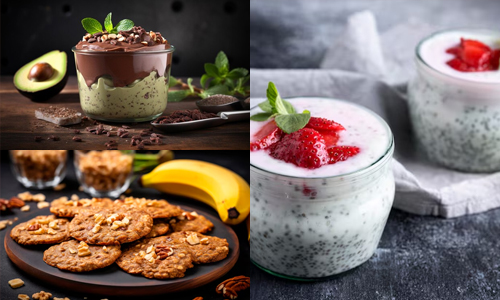Ever felt the pull of a doughnut or heard a chocolate bar whisper your name at midnight? Welcome to the sugar bomb effect—where sweet cravings explode in your brain, promising bliss but often leaving a messy aftermath. Sugar taps into your brain’s reward system, giving you a fleeting high but paving the way for crashes, mood swings, and endless cravings. Why does sugar have such a hold on us, and how can we navigate this sweet chaos? Let’s unwrap the layers of this tantalizing trap.
The Anatomy of a Craving: Why We Want Sugar So Badly

You’re minding your business, and boom—a sugar craving hits out of nowhere. But why? Here’s the scoop!
Quick Energy Fix

Sugar is like caffeine’s sweet cousin. It gives your body an instant jolt of energy by spiking your blood sugar levels.
Stress and Emotions

Feeling down or stressed? Sugar triggers the release of feel-good hormones like serotonin, making you feel like you’re wrapped in a warm, sugary hug.
Habitual Hunger

Ever noticed how your hand automatically grabs a cookie post-lunch? That’s your brain loving the habit you’ve created.
Sugar: The Sweet Assassin

Before you dive headfirst into that jar of gummy bears, let’s talk about the consequences. Sure, sugar tastes like happiness, but here’s what happens when you overdo it.
- Weight Gain – Excess sugar gets stored as fat, turning you into a walking candy bar (metaphorically, of course).
- Mood Swings – That sugar high? It’s followed by a crash that leaves you cranky and tired.
- Dental Damage – Sugar feeds bacteria in your mouth, causing cavities and leaving your dentist richer.
- Increased Risk of Chronic Diseases – Over time, too much sugar can lead to diabetes, heart disease, and other serious health problems.
- Skin Sabotage – Say hello to breakouts and premature aging, courtesy of sugar’s inflammatory properties.
Types of Sugars
Not all sugars are created equal, folks. Let’s meet the sugary suspects!
- Natural Sugars – Found in fruits, honey, and milk. These come with nutrients, so they’re the good guys.
- Added Sugars – The villains hiding in sodas, candies, and baked goods. They offer zero nutritional value but pack on the calories.
- Hidden Sugars – Lurking in “healthy” items like granola bars and flavored yogurts. Always check labels for sneaky names like sucrose or maltose.
Why Does Sugar Feel So Good?

Blame your brain! Sugar activates the reward center, releasing dopamine—the same feel-good chemical triggered by things like hugs and… other enjoyable activities. Essentially, sugar turns you into a pleasure-seeking missile.
How to Tame the Sugar Monster?
Tired of sugar running your life? Here are some hacks to regain control:
- Stay Hydrated – Sometimes, thirst disguises itself as a craving. Drink water first.
- Balance Meals – Include protein, healthy fats, and fiber to keep you full and less tempted.
- Mindful Substitutes – Swap sugary desserts for fruits, dark chocolate, or a drizzle of honey on yogurt.
- Distract Yourself – Go for a walk, call a friend, or binge-watch cat videos until the craving passes.
- Practice Moderation – It’s okay to indulge occasionally. Just don’t let sugar be your BFF.
When the Cravings Win: Is All Hope Lost?
Let’s get one thing straight—losing a battle to a cookie (or three) doesn’t mean you’ve lost the war. Life is about balance, not perfection. Beating yourself up for overindulging in a sugar craving can sometimes do more harm than the sugar itself. So, let’s reframe those moments of “weakness” as opportunities to learn and reset.
1. Understand the Why
Cravings often arise for a reason. Are you stressed, tired, or maybe just bored? Understanding what triggered the craving can help you manage it better next time. Maybe you skipped a meal, or maybe that chocolate cake at the office was just too tempting. A little self-awareness can go a long way.
2. Enjoy the Indulgence
If you’ve given in to the sugar, enjoy it guilt-free. Seriously, savor every bite. Feeling guilty while eating can ruin the experience and make you more likely to overdo it later. Instead, think of it as a treat, not a failure.
3. Reset With Your Next Meal
The beauty of life is that there’s always a “next time.” Follow up your sugary indulgence with a balanced meal packed with protein, healthy fats, and fiber. This stabilizes your blood sugar and prevents a post-sugar crash that can lead to even more cravings.
4. Hydrate, Hydrate, Hydrate
Water is your best friend post-craving. It helps flush out excess sugar and rehydrates your body. Add a slice of lemon or cucumber to your water for a refreshing detox-like effect.
5. Get Moving
A quick walk or a few stretches can help burn off some of that extra sugar while boosting your mood. Plus, moving your body after a treat creates a sense of balance and control.
6. Forgive and Forget
One sugary snack doesn’t define your health journey. The key is to not let one slip turn into a spiral. Remind yourself that progress is about consistency, not perfection. Tomorrow is a new day.
7. Plan for Next Time
If cravings keep sneaking up on you, it might be time to strategize. Stock your pantry with healthier options like dark chocolate, nuts, or dried fruit to satisfy your sweet tooth without overloading with sugar.
8. The 80/20 Rule
Remember, life isn’t meant to be lived in extremes. If you eat healthily 80% of the time, there’s room for that 20% where you indulge guilt-free. A balanced approach is sustainable and keeps you sane.
In the end, sugar cravings aren’t the enemy—they’re just a part of being human. The goal isn’t to banish them completely but to handle them in a way that feels good for your body and mind. So, when the cravings win, dust yourself off, smile, and get back to your groove.
Sugar-Free Recipes That Taste Like Dessert

Who says cutting sugar means cutting joy? You can have your cake and eat it too—literally—with these sugar-free dessert ideas. Let’s dive into the world of guilt-free indulgence.
- Chocolate Avocado Mousse – Yes, you heard it right. Blend ripe avocados, unsweetened cocoa powder, a splash of almond milk, and a drizzle of natural sweetener like stevia or honey. The result? A rich, creamy, chocolatey dessert that feels sinful but is oh-so-good for you.
- Banana Oat Cookies – Mash ripe bananas, mix them with rolled oats, a handful of dark chocolate chips, and bake. No added sugar needed—the bananas bring all the sweetness.
- Coconut Chia Pudding – Mix chia seeds with unsweetened coconut milk and a touch of vanilla extract. Let it set overnight for a creamy pudding that’s perfect for breakfast or dessert.
These recipes prove that you don’t need processed sugar to enjoy something sweet and satisfying. Plus, they’re loaded with nutrients that keep your body happy.
Sweet Dreams? Sugar’s Effect on Your Sleep
You know that late-night ice cream binge? It might be why you’re tossing and turning at 2 a.m. Sugar affects your sleep in sneaky ways.
- The Energy Spike – Sugar gives you an immediate energy boost, but when that spike crashes, it can leave you feeling restless and anxious.
- Hormonal Hijack – Excess sugar can interfere with the balance of insulin and cortisol, two hormones that play a big role in sleep regulation.
- Disrupted REM Sleep – Too much sugar before bed has been linked to fewer deep sleep cycles, meaning you wake up feeling less refreshed.
Want sweet dreams? Ditch the sweets a few hours before bedtime. Opt for sleep-friendly snacks like a handful of nuts or a warm cup of chamomile tea instead.
Natural Alternatives: Sweet Without the Guilt

Craving something sweet but want to dodge the sugar bomb? Natural sweeteners to the rescue! Here are some guilt-free options that won’t mess with your health:
- Honey – Packed with antioxidants and nutrients, honey is nature’s liquid gold. Use it sparingly in tea, yogurt, or baking.
- Maple Syrup – Real maple syrup (not the imitation kind!) adds a rich, earthy sweetness to dishes without overwhelming your palate.
- Stevia – Derived from the stevia plant, this zero-calorie sweetener is perfect for coffee or smoothies. Just a little goes a long way.
- Dates – Nature’s candy! Blend them into desserts, chop them into salads, or eat them as is for a chewy, caramel-like treat.
- Monk Fruit – This Asian fruit-based sweetener has zero calories and doesn’t spike blood sugar. Ideal for baking and cooking.
These alternatives prove that you can have all the sweetness without the sugar crash. So, next time you’re reaching for the sugar jar, consider these options instead—your body will thank you.
How Much Sugar is Too Much? Know Your Limits
Sugar is sweet, but too much of it can quickly turn sour—especially for your health. So, how do you know when to draw the line? Let’s break it down and set some boundaries for this sugary relationship.
The Expert-Approved Limits
According to the World Health Organization (WHO), your daily sugar intake should be less than 10% of your total calorie intake. For most adults, that’s about 25 grams (or six teaspoons) of added sugar per day. To put that in perspective, a single can of soda often packs more than 30 grams of sugar—oops, there goes your daily quota.
Natural vs. Added Sugars
As stated earlier, not all sugars are created equal. The natural sugars found in fruits, vegetables, and dairy are accompanied by fiber, vitamins, and minerals, making them a healthier choice. The real troublemakers are added sugars, which sneak into processed foods, sugary drinks, and desserts with little to no nutritional benefit.
Spotting Hidden Sugars
Sugar isn’t always obvious. Food labels often use sneaky aliases like high-fructose corn syrup, sucrose, maltose, and even “evaporated cane juice.” Reading nutrition labels is your first defense against unknowingly crossing your sugar limit.
How to Stay Within Your Limits?
- Read Nutrition Labels Carefully
- Swap Sugary Drinks for Water or Herbal Teas
- Choose Whole Foods Over Processed Snacks
- Limit Sugary Desserts to Special Occasions
- Use Natural Sweeteners Instead of Sugar
- Prepare Meals at Home to Control Ingredients
- Opt for Unsweetened Dairy and Plant-Based Products
- Snack on Fruits Instead of Candy
- Track Your Daily Sugar Intake
- Train Your Taste Buds to Enjoy Less Sweetness
Sugar may be sweet, but its impact on your health isn’t always a treat. It’s the ultimate frenemy—tempting, comforting, and oh-so-satisfying in the moment, but often leading to crashes, cravings, and more. The key isn’t cutting sugar out entirely but finding balance. Enjoy the occasional treat, savor the sweetness, but keep your health in focus. After all, life is about enjoying the flavors, not letting them control you. So next time you face a sugar bomb moment, choose wisely—and savor it guilt-free.
Linda
Related posts
Women Tips
Privacy Overview
| Cookie | Duration | Description |
|---|---|---|
| cookielawinfo-checkbox-analytics | 11 months | This cookie is set by GDPR Cookie Consent plugin. The cookie is used to store the user consent for the cookies in the category "Analytics". |
| cookielawinfo-checkbox-functional | 11 months | The cookie is set by GDPR cookie consent to record the user consent for the cookies in the category "Functional". |
| cookielawinfo-checkbox-necessary | 11 months | This cookie is set by GDPR Cookie Consent plugin. The cookies is used to store the user consent for the cookies in the category "Necessary". |
| cookielawinfo-checkbox-others | 11 months | This cookie is set by GDPR Cookie Consent plugin. The cookie is used to store the user consent for the cookies in the category "Other. |
| cookielawinfo-checkbox-performance | 11 months | This cookie is set by GDPR Cookie Consent plugin. The cookie is used to store the user consent for the cookies in the category "Performance". |
| viewed_cookie_policy | 11 months | The cookie is set by the GDPR Cookie Consent plugin and is used to store whether or not user has consented to the use of cookies. It does not store any personal data. |

